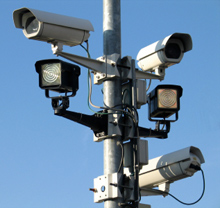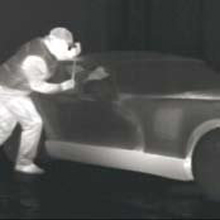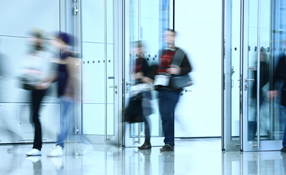Today, the challenge to video surveillance professionals is to make sure that the CCTV video footage is effective on a 24/7 basis throughout the year. Securing an area during the daytime is one thing. But what happens during the night? And in weather conditions like fog, rain and snow? What can be detected if the sun blinds CCTV cameras? Flir Systems explains.
As CCTV systems become more advanced, the security industry will move to raise the standard for all CCTV installations to be designed for 24-hour surveillance, not just daytime operation. To be truly secure, a site must be protected day and night.
A number of tools are available to help detect potential intruders in the dark. Fences can be complemented with CCTV systems with or without active infrared illumination or old-fashioned light bulbs, Radio Frequency Intruder Detection (RAFID) systems, thermal imaging cameras and/or walking patrols. Whatever solution or technology is chosen for securing an area, they all have their advantages and disadvantages and some technologies are more expensive than others. To get a full picture of the Total Cost of Ownership (TCO) for a certain security solution, not only the initial installation cost but also the maintenance cost needs to be taken into account.
Environmental and energy consumption issues are high on the global agenda today. Given that $1 from every $5 spent globally is used on lighting-and much of this is spent on inefficient and unnecessary lighting- particular attention should be given to this area. Local authorities and private industries are all looking at methods to save energy costs and lighting is one area due for careful attention.
Let´s compare some of the technologies available to help detect potential intruders in the dark before they become a real hazard :
CCTV combined with traditional lighting
$1 from every $5 spent globally is used on lighting and much of this is spent on inefficient and unecessary lighting |
CCTV systems have been an effective tool for security and surveillance applications. However, just like the human eye, CCTV cameras do not see too much in total darkness. So in order to detect intruders at night they are often complemented with traditional lights by mains-driven bulbs. Although some bulbs (fluorescent lamps, HID lamps) are more efficient than others, the operational cost is very high. Light can only penetrate a certain distance and completely illuminating an area, so that it can be kept under the surveillance range of CCTV cameras, is not always possible.
There is significant labour and material cost associated with lamp replacement. CCTVs with traditional lamp lighting require lamp replacement every 2000 to 4000 hours or about every 8 months. Another aspect is light pollution. This is an increasingly hot political topic given recent government legislation to control and punish light pollution. Symptoms include glare, clutter over illumination and sky glow. Furthermore, lighting essentially lays out a route of attack for intruders, creating shadows in which they can hide and access undetected.
CCTV combined with LED's
Compared to any bulb, LEDs provide significant savings on electrical consumption. LEDs have a long life performance with little ongoing maintenance costs. Infrared illumination with LEDs, sometime also called active infrared, beams infrared radiation into the area in front of a camera. The LEDs are often placed around the lens of the camera. LED illumination is compromised by limited range performance. Also, providing lighting for domes has long been a challenge for CCTV professionals, as the lighting cannot be fitted to move with the camera.
Electrified fences
In order to keep intruders out of certain areas, fences can be constructed. To further increase security, fences can be equipped with sensors that generate an automatic intruder alarm when someone touches the fence. Or they can be electrified, to keep intruders away. In all cases, fences need to be complemented by other technologies such as CCTV cameras or walking patrols in order to see what is happening around the fence.
Radio Frequency Intruder detection (RAFID)
 |
| Lighting must be taken into consideration to ensure that CCTV systems are effective regardless of the weather conditions |
The simplest description of RAFID is to consider a system using two specially designed cables - one transmitting a radio wave, while the other receives that wave.
Changes in the amount of signal passing between the transmitter cable and receiver cable are analysed by a signal processor. If the amount of signal changes, this means that someone or something is between the two cables and an alarm will go off. Due to the difference in the signal strength, the system can detect whether these changes are due to the presence of a human, a small animal, etc.
Note that in a lot of cases CCTV cameras still need to be installed in order to see what is generating a real, or false, alarm.
Thermal imaging
A new tool for seeing in total darkness, in the most adverse weather conditions is thermal imaging, which is the use of a thermal imaging camera to "see" thermal energy emitted from an object. Thermal imaging cameras produce images of invisible infrared or "heat" radiation. Based on temperature differences between objects, thermal imaging produces a crisp image on which the smallest of details can be seen. They work both during daytime and nighttime.
Most thermal imaging cameras contain an uncooled Vanadium Oxide detector. Not only does it produce excellent quality thermal images, since it does not contain any moving parts, but it also needs no maintenance.
Deciding which perimeter protection technique to use
Security managers are more familiar with certain technologies than with others. Before making a final decision about which technology or solution is to be implemented to secure a perimeter at night, it is a good idea to have a look at the advantages and disadvantages of each technology.
This table summarises the different technologies and their advantages / disadvantages.
| Technology | Advantages | Disadvantages |
| CCTV with traditional lighting or LED |
|
|
| Electrified Fence |
|
|
| RAFID or Sensor Cable |
|
|
| Thermal imaging |
|
|
Thermal imaging cameras - a cost effective choice
 |
| Thermal imaging cameras generate fewer false alarms which is a common problem with CCTV cameras combined with video motion detection |
Although all technologies have advantages and disadvantages, a small calculation makes it clear that thermal imaging is a very good and a very cost effective solution for protecting a perimeter.
Although a thermal imaging camera is more expensive than a CCTV camera, fewer cameras need to be deployed to cover the same area. The civil works that need to be carried out are minimal. In some cases the cameras can even be mounted on existing structures. Furthermore, since thermal imaging cameras produce a clear image in the darkest of nights, no complimentary technologies like light or infrared illuminators need to be installed. This translates to reduced maintenance costs.
Thermal imaging cameras also generate fewer false alarms, which is a common problem with CCTV cameras combined with Video Motion Detection or Video Content Analysis software. Taking into consideration the pros and cons of the other technologies, as table shows, thermal cameras represent the most cost-effective choice when analyzing the different surveillance, access control and intruder detection options on a cost / performance basis.
 | FLIR Commercial Vision System B.V |





















